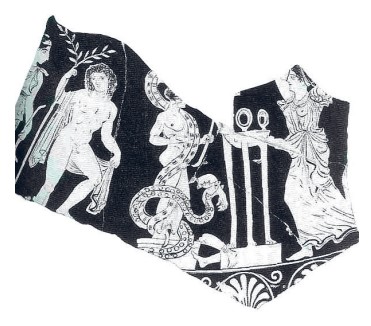Terracotta Vase (c. 375 BCE)

A Laocoön scene appears on the pieced-together fragments (incomplete) of a 4th century BCE terracotta vase held in the Museo Archeologico Nazionale Jatta, Ruvo di Puglia. From the 8th to the 3rd century BCE, Puglia was a Greek colony. Later, in 272 BCE, Puglia was conquered by the Roman Republic. Like Etruria, then, Puglia provided route by which Greek culture entered into Roman culture.
The scene depicted on the vase fragment shows a statue of Apollo entwined by a pair of serpents. The head of one of the serpents is cut off by a breakage in the vase but the serpent still visible is shown biting into a disembodied right arm. At the statue's feet lie two disembodied legs (right and left). The other (left) arm, then, was probably in the mouth of the serpent whose head is missing.
To the right of the statue, separated from it by a votive tripod, a female figure appears to be hurrying towards the scene with her arms raised in distress: this is undoubtedly Laocoön's wife. other (left) arm, then, was probably in the mouth of the serpent whose head is missing.
To the left of his statue, Apollo himself is depicted holding a laurel. To the left of the god is another female who may be Apollo's sister, the goddess Artemis.
A distinct Laocoön figure is not present on this fragment. It could be that the body parts are his but that leaves the question of where his sons are: at least one of Laocoön's sons is killed by the serpents in all extant ancient versions of his story, whereas Laocoön himself is sometimes spared death (if only to have to live with his responsibility for his son's/sons' death).
If the body parts belong to one or both of Laocoön's sons, then the omission of Laocoön himself is striking. It could be that Laocoön was originally depicted in a lost fragment, perhaps hurrying after his wife towards the scene of the tragedy. Richard Foerster, however, argued, in 1906, that this is thoroughly implausible:
Welcher antike Dichter oder Künstler wäre eines solchen unnatürlichen Gedankens fähig, in einem solchen Augenblick dem in erster Linie berufen Helfer, dem Vater, den Platz hinter der Frau zu geben? Auch moderne Künstler haben dies nicht getan.[note]
For which ancient writer or artist would so unnatural a thought be possible—in a moment that calls above all for aid—to give the father a position behind his wife? Even modern artists have not done this. (My translation)
Foerster goes on to suggest that Laocoön has already fallen victim to the serpents and lies on the ground behind his wife. That is certainly possible; equally possible, though, is that Laocoön's son(s) lie on the ground behind his wife, since they seem always to be attacked first. Since all that remains of the visible victim, however, is disembodied limbs, it is also a moot point whether or not the artist would have depicted either Laocoön or his sons dead on the ground and identifiable.
Wherever Laocoön was on this vase, it is perhaps more significant that the statue is of Apollo, and not of Neptune or Athena, in the context of whom Laocoön later appears. The appearance of Laocoön's wife and Apollo links this image to the version of the story found in Sophocles' Laokoon.
Note. Richard Foerster, "Laokoon", Jahrbuch des Kaiserlich Deutschen Archaologischen Instituts, 21 (1906): 1–32 at p. 16. [back to text]
Resources available


